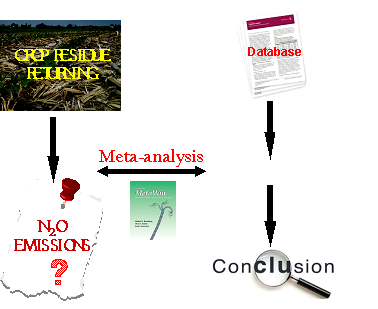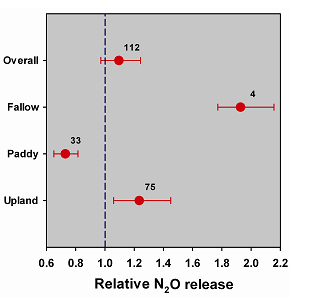Agricultural soils are an important anthropogenic source of nitrous oxide (N2O) and crop residue returning is a common practice in agricultural system which consequently influences N2O emissions. Although many individual laboratory and field experiments have been conducted to evaluate the effects of crop residue returning on N2O release, no systematic and general conclusion has yet been drawn because environmental factors among different studies vary.
So Dr. Jun Shan and Prof. Xiaoyuan Yan performed a comprehensive and quantitative analysis of crop residue returning on N2O emissions in agricultural soil using meta-analysis based on the existing 112 scientific assessments from previous published studies (Fig. 1).
|

|
|
Figure 1. Schematic diagram of the research
Results of the meta-analysis showed that crop residue returning, when averaged across all studies, had no statistically significant effect on N2O release compared with control treatments. However, the range of effects of crop residue returning onN2Oemission was significantly affected by synthetic nitrogen (N) fertilizer application, type of crop residue, specific manner in which crop residue has returned, and types of land-use.N2Orelease was significantly inhibited by 11.7% and 27.1% (P<0.05) when crop residue was with synthetic N fertilizer and when type of land-use was paddy, respectively. While N2O emissions were significantly enhanced by 42.1% and 23.5% (P<0.05) when crop residue was applied alone and when type of land-use was upland, respectively.N2Oemissions were likewise increased when crop residue with lower C/N ratio was used, mulching of crop residue was performed, and type of land-use was fallow.
|

|
|
Figure 2. Effect of land-use type on N2O emission fluxes, shown as relative release (N2O release from control treatments is equal to one). Means with 95% CIs are shown. Numbers above symbols represent amounts of assessment. Categories of fallow, paddy, and upland indicate current seasonal land-use type
|
This study provides the first quantitative analysis of crop residue returning on N2O emissions, indicating that crop residue returning has no statistically significant effect on N2O release at regional scale, and underlining that the Intergovernmental Panel on Climate Change guidelines should take the opposite effects of crop residue returning on upland and paddy into account when estimating the N2O emission factor of crop residue for different land-use types (Fig .2).
The research results entitled “effects of crop residue returning on nitrous oxide emissions in agricultural soils” have been published in the journalAtmospheric Environment(Volume 71, Page 170-175, June 2013) on the website ofhttp://www.sciencedirect.com/science/article/pii/S1352231013001106.
|
